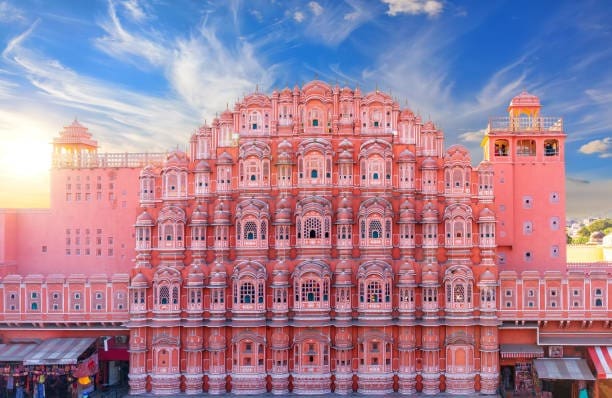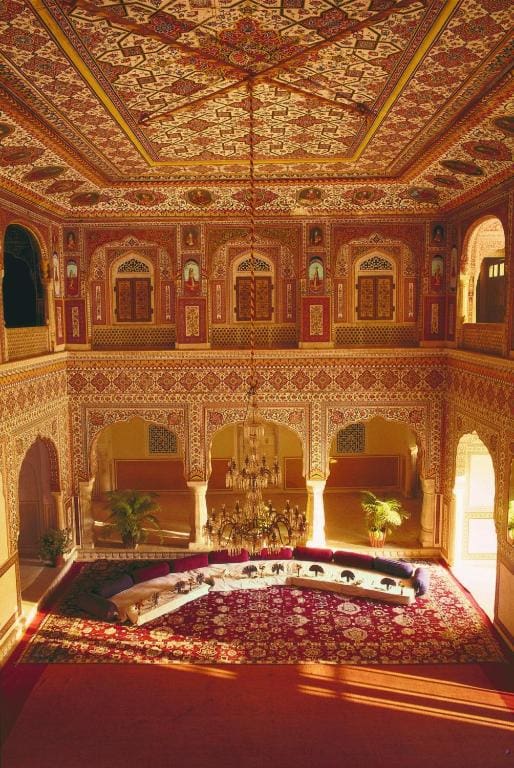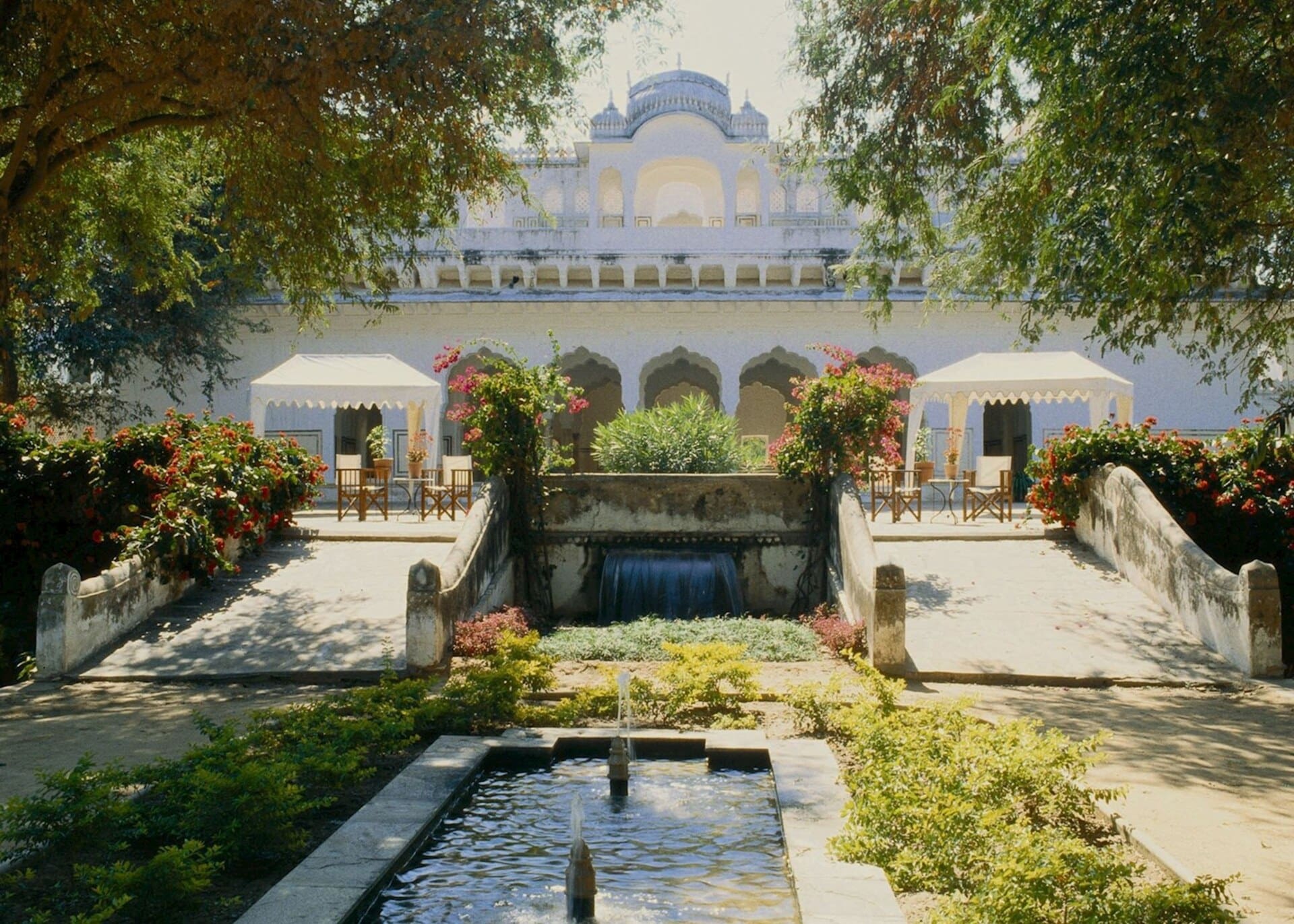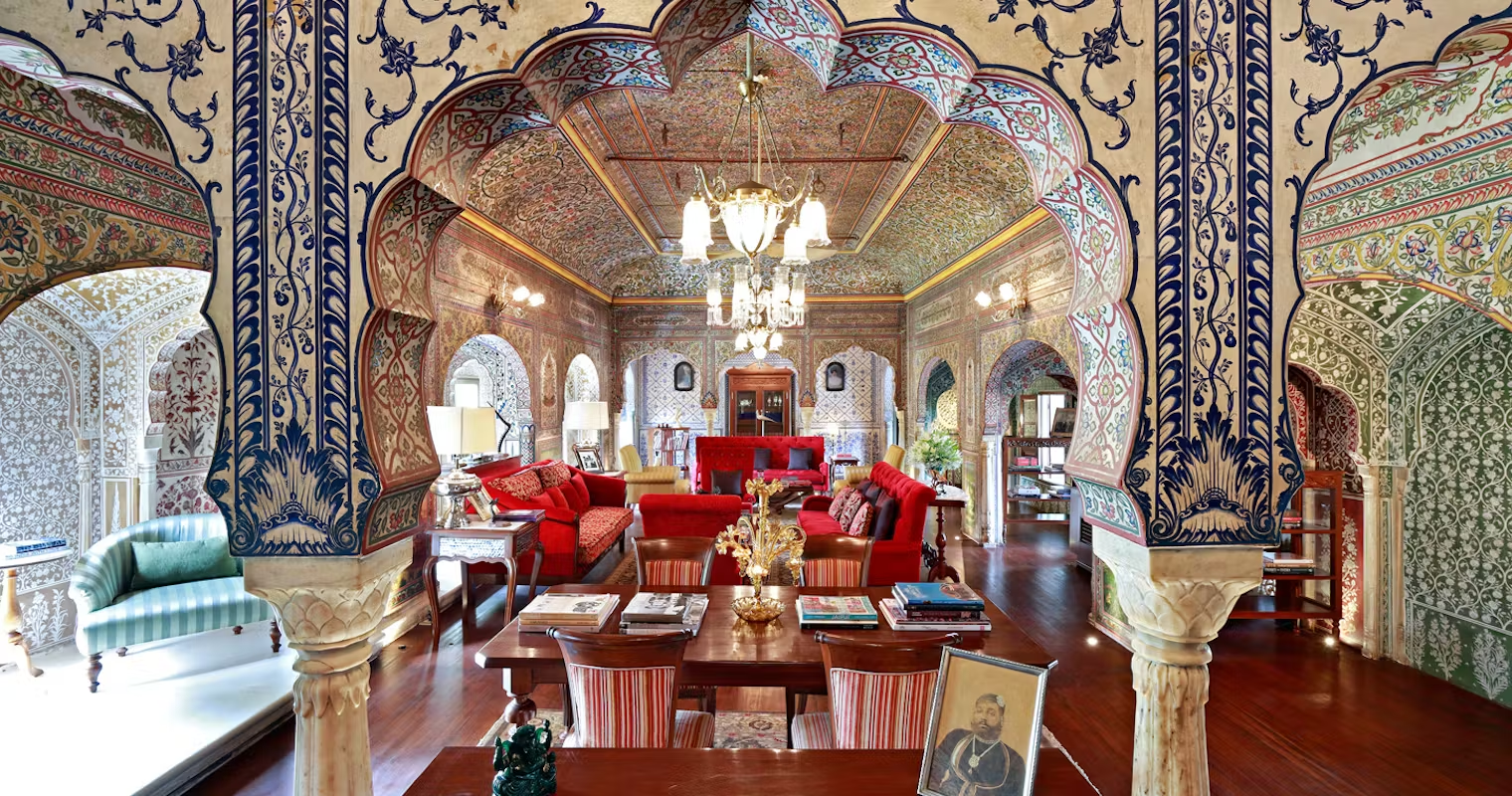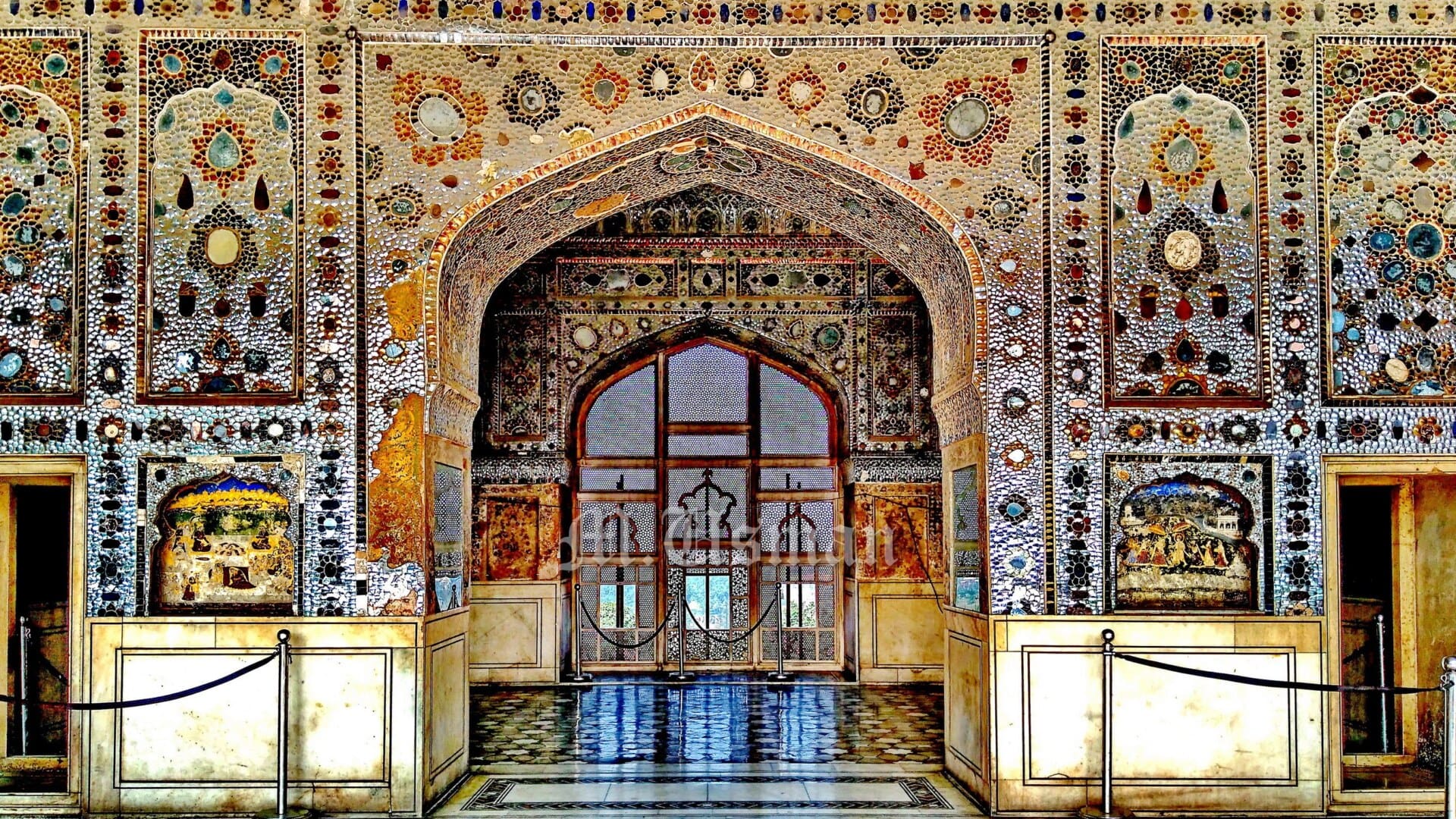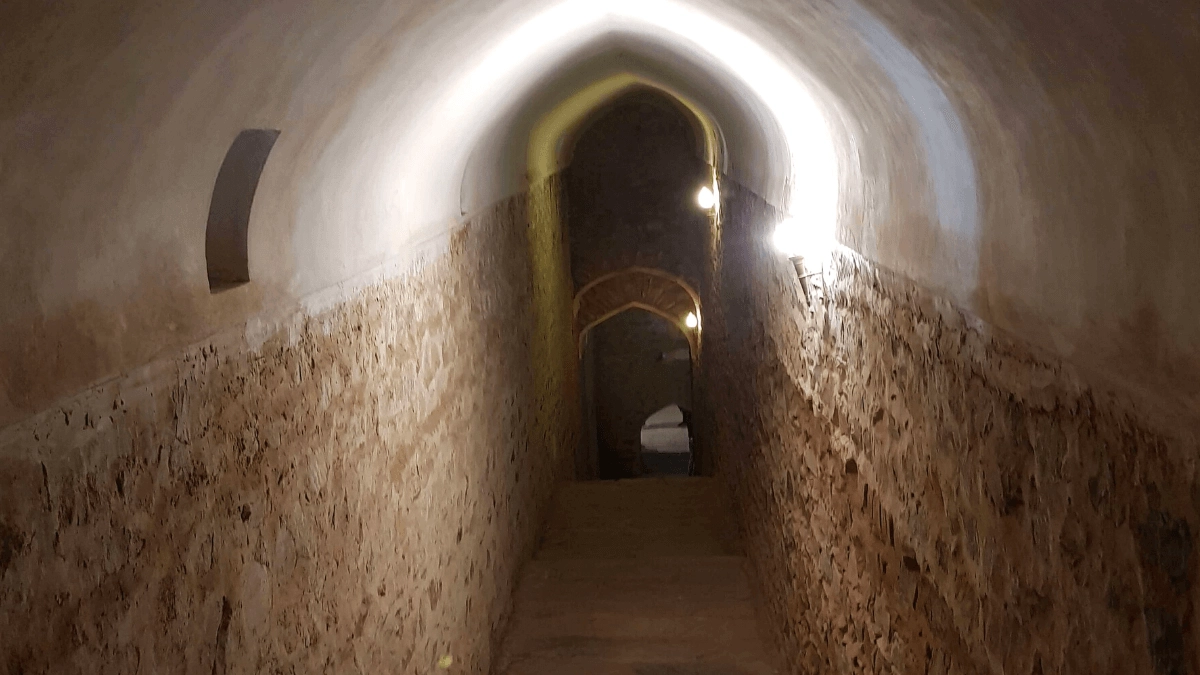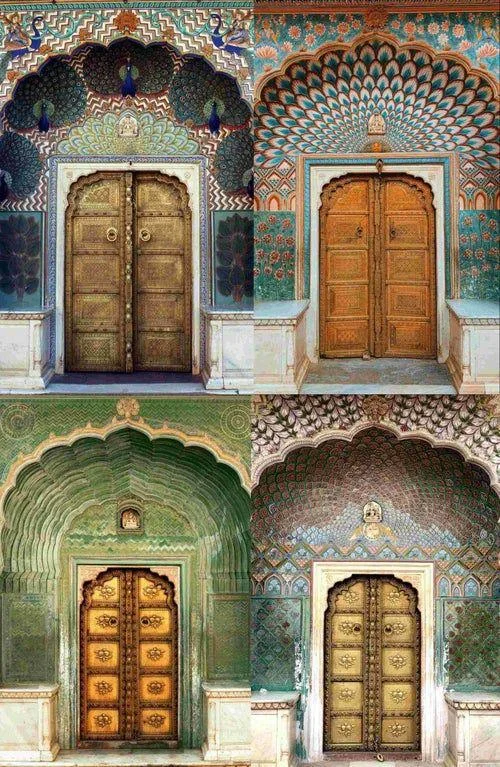Jaipur, located in the heart of Rajasthan, India, exemplifies the majesty of the country’s rich history and cultural legacy. Jaipur, nicknamed the “Pink City” because to its distinctive rose-colored architecture, entices visitors with its labyrinthine streets, imposing forts, and colorful bazaars. As one of India’s most alluring places, Jaipur flawlessly blends centuries of history, artistic magnificence, and modern attractiveness, providing visitors with an unparalleled voyage through time.
Jaipur’s attractiveness stems from its historic past, which began in 1727 with the founding of the city by Maharaja Jai Singh II. Jai Singh II, a visionary emperor and avid astronomer, solicited the help of architect Vidyadhar Bhattacharya to create the city using old Hindu architectural principles. The end result was a beautifully planned metropolis studded with imperial palaces, gorgeous temples, and finely carved facades that reflected the splendor and grandeur of Rajasthan’s royal history.
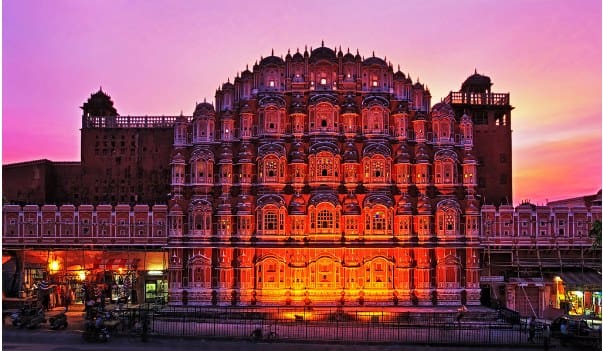
Step into a world of royal intrigue and architectural splendor at Hawa Mahal – where every window whispers secrets of a bygone era.
Maharaja Sawai Pratap Singh built the Hawa Mahal in 1799, and it is a spectacular example of Rajputana architecture. Its remarkable five-story exterior mimics Lord Krishna’s crown, with numerous small windows and elaborate latticework designed to resemble a beehive’s honeycomb.Lal Chand Usta, an architect, built the palace, which was Maharaja Sawai Pratap Singh’s favorite resort. The Hawa Mahal architecture is distinguished by its five-story tiered structure, which rises to around 50 feet. The elevated façade resembles a honeycomb, with small portholes containing smaller windows, carved sandstone grills, and finials.
The Hawa Mahal’s principal purpose was to allow royal women to witness street processions and daily life without being observed by the public. The facade’s distinctive design, with its small windows (953 in all), provided privacy for the women while also allowing for ventilation and air movement, thus the name “Palace of Winds.”
Despite its magnificent facade, the Hawa Mahal’s interior is quite modest, consisting primarily of small chambers and corridors. The structure was meant to gather cold breezes from adjacent mountains and direct them through the chambers, providing natural air cooling during the hot summer months. The place is both a tribute to the genius of Rajput construction and a symbol of Rajasthan’s rich cultural history. Its magnificent front, embellished with elaborate carvings and brilliant colors, evokes the luxury and grandeur of Jaipur’s royal courts.
One of Jaipur’s most enchanting sites is the Hawa Mahal, which is lighted against the night sky. After dusk, the palace’s exterior is illuminated with soft lights, creating a magnificent radiance that captivates tourists and evokes the magnificence of Rajasthan’s royal past. Because of its breathtaking beauty and historical significance, the Hawa Mahal has been used as a setting for countless Bollywood films and television series. Its magnificent exterior has become synonymous with Jaipur’s romantic charm, captivating audiences both on and offscreen.
This is one of Jaipur’s most prominent tourist sites, attracting visitors from all over the world to admire its unique architecture and historical significance. Tourists can explore the palace’s interior, climb to the higher floors for panoramic views, and learn about its rich history via guided tours and displays.
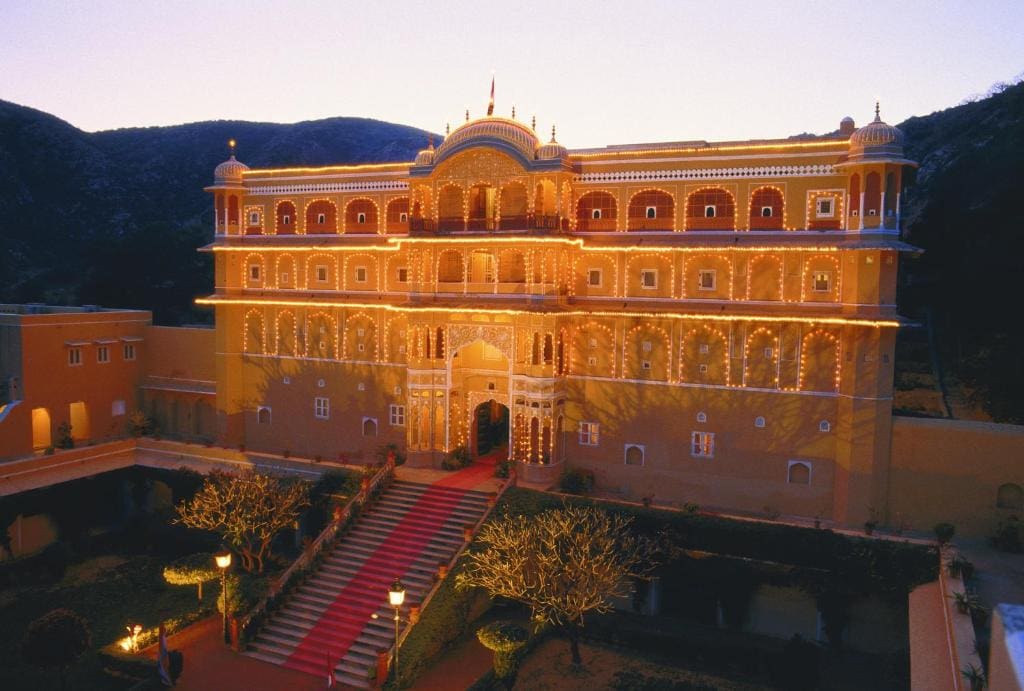
Explore the antique havelis, witness traditional arts and crafts, and indulge in the cultural festivities that bring this quaint hamlet to life!
One of Samode’s highlights is the majestic Samode Palace, which is a stunning example of Rajput-Mughal architecture. The palace, built over 400 years ago by the noble family Rawals of Samode, is well-known for its lavish interiors, elaborate murals, and ornate mirror work. Today, it serves as a luxury hotel, giving guests the opportunity to experience royal hospitality in regal surroundings.
The entrance gate to the Samode palace is ornamented with a large treasure chest made of dark wood embossed with marble settings and glittering glass. The Sheesh Mahal is located on the south flank of the palace. There are several frescos on the durbar hall wall and it is anticipated that Sultan Mahal of the Samode Palace is more than 250 years old. The palace is built on three levels, which are organized into ascending courtyards. Each story features a patio. A watch tower was built on the palace’s top floor, which has since nearly collapsed, and visitors can enjoy a panoramic view of the surrounding area from here.The first one, as implied by the name, is made of exquisite glass design and the second one was massive hall for conference. The wall and ceiling of this royal hall was completely hand painted. In the year 1987, the palace was converted into Samodee Palace Hotel.
Samode Bagh, The Enchanted Garden
Samode Bagh is not just a garden it’s a sanctuary of tranquility and natural beauty nestled within the historic town of Samode in Jaipur. What makes Samode Bagh truly special is its rich historical legacy dating back to the Mughal era. Originally built as a vast garden complex by the Mughal emperors, Samode Bagh has retained its timeless charm and allure through the centuries.One of the sons of Jaipur’s Maharaja Prithiraj Singhji landscaped Samode Bagh, also known as Samode Garden, about 150 years ago. It was designed along the lines of Mughal gardens, which the Mughals had established in other parts of their empire as a haven for relaxation and enjoyment.
Visitors to Samode Bagh are met by lush foliage, aromatic flowers, and quiet water features, creating a tranquil oasis amidst the hustle and bustle of city life. The perfectly groomed gardens give the ideal setting for leisurely strolls, romantic picnics, or simply admiring nature’s splendor.
What sets Samode Bagh apart is its role as a cultural hub, hosting a variety of events and celebrations throughout the year. From traditional festivals to music and dance performances, the garden comes alive with the vibrant colors and sounds of Rajasthan’s rich cultural heritage. These events offer visitors a unique opportunity to immerse themselves in the local traditions and customs, creating memories that last a lifetime.
Furthermore, Samode Bagh is more than simply a place to observe nature it is also a place to unwind and recharge. Visitors can relax in the peaceful settings, contemplate by the tranquil water bodies, or simply enjoy the grandeur of the Aravalli Hills that surround the garden. For those looking for adventure, the garden provides opportunity for bird observation, photography, and even outdoor yoga sessions in the magnificent surroundings.
Samode Haveli: A Historical Gem Amidst Rajasthan’s Heart
In Rajasthan, a state with a strong regal heritage, havelis can be seen at regular intervals. Amidst this wealth, many of these architectural marvels have succumbed to the ravages of time, becoming mere echoes of their once-brilliant past. However, a select handful remain unwavering, bearing the weight of history with incredible fortitude. The 225-year-old Samode Haveli exemplifies this enduring attitude, beautifully conserving history within its walls and arches.
As one walks through the labyrinthine, twisting halls of Samode Haveli, it’s as if time has stopped in some parts of this vast mansion. This haveli, with its two-century legacy of luxury, conjures the atmosphere of a film masterpiece. It was formerly exclusive for the elite, but now it invites curious visitors, transporting them to a world of timeless elegance and enthralling stories.
Decorative Walls Embellished with Artwork
Samode is also known for its rich legacy of arts and crafts, such as miniature painting, hand-block printing, and needlework. Visitors to the hamlet can visit local workshops and artisanal studios, where experienced artisans make stunning pieces of art using centuries-old traditions passed down through generations. Samode’s craft tradition ranges from colorful textiles to intricately carved wooden furniture, making it a sensory feast.
Throughout the year, Samode holds a number of cultural festivals and events that highlight Rajasthan’s vibrant traditions. These events, which include folk music and dance performances as well as traditional Rajasthani cuisine, provide visitors with a unique opportunity to immerse themselves in the region’s rich cultural tapestry. One of the most popular events is the Samode Bagh Festival, which showcases the beauty of spring via music, dance, and flower displays.Samode, nestled in the scenic Aravalli Hills, is known for its spectacular natural beauty and panoramic views. Visitors may explore the mountainous landscape with picturesque treks, camel safaris, or jeep excursions, discovering hidden jewels like old temples, tranquil lakes, and small towns. The peaceful atmosphere of Samode’s countryside is a pleasant change from the rush and bustle of city life.
Unveiling the Mysteries: Fascinating Facts About Amber Fort
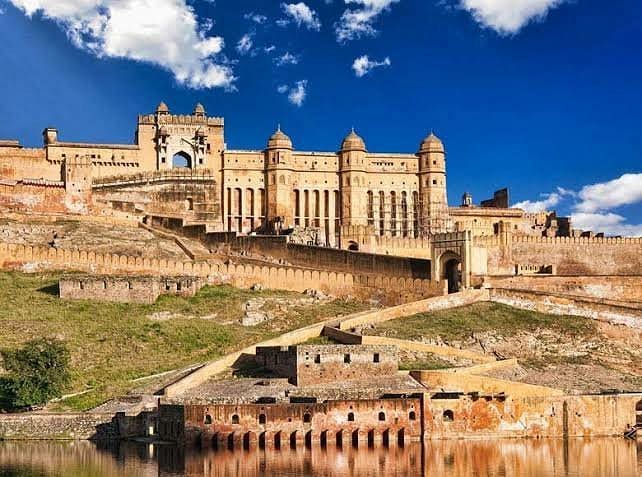
Raja Alan Singh, a prince from the Chanda tribe of Meenas, erected Amber Fort, Jaipur, in 967 CE. During Raja Man Singh’s reign, the current Amer Fort was built on the foundations of the previous construction. It was expanded by his descendant, Jai Singh 1. Amer Fort was further improved and expanded by their successors until the Kachwahas relocated their headquarters to Jaipur in 1727, under the rule of Sawai Jai Singh 11.
The current monarchs’ house, the Amer royal palace, was built in the 16th century. The Rajput Maharajas built the beautiful towers of the Amer Fort and Palace in the 16th century, which are still in excellent condition. The Amer Fort was built with red sandstone and marble, and the Moatha Lake adds to the area’s attractiveness.The Amer Fort may be reached by either taking an exhilarating elephant ride or walking up the hill.
The views from the elephant ride are breathtaking, especially the ones across Moatha Lake. The Amer Fort also has a nighttime Light Show. The museum and park inside the fort are stunning. From the Char Garden, one can see the entire city. A dance program at the Sukh Mahal relaxes your soul, while a dish at the Surabhi restaurant inside the fort is mouth-watering.
1) Sheesh Mahal is a dazzling spectacle where mirrors reflect not just light, but also centuries of royal opulence and artistic brilliance!
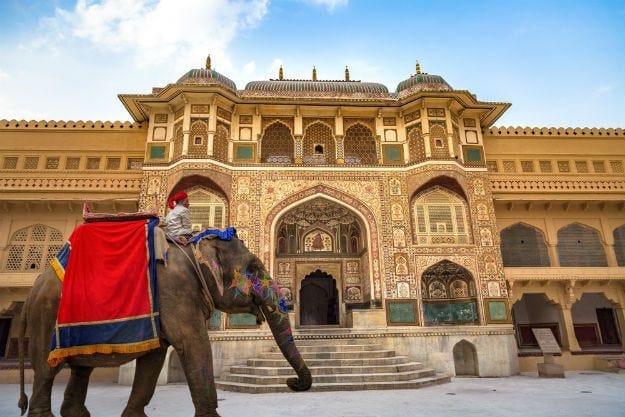
2) Ganesh Pol: Gateway to Grandeur
Ganesh Pol, located in the heart of Rajasthan’s Amber Fort, is a beautiful gateway steeped in history and architectural magnificence. This elaborate gateway, covered with beautiful murals and carvings, serves as a tribute to the grandeur and wealth of the Rajput monarchs who once controlled this land. Ganesh Pol, also known as Ganesh Gate, is named after the Hindu deity Lord Ganesh, the remover of barriers and god of beginnings. The kings and queens of Amber Fort entered their royal dwelling through this doorway, under the watchful gaze of the elephant-headed god.
Ganesh Pol, built in the early 17th century by Maharaja Man Singh I, represents the fort’s architectural beauty and strategic importance. Its massive construction and elaborate design were intended to amaze tourists while also providing a powerful defense against prospective invaders. The gateway’s exterior is embellished with exquisite murals representing themes from Hindu mythology, demonstrating the artistic prowess of the craftsmen who worked hard to bring the king’s vision to life. Each panel narrates a story, ranging from acts of valor and heroism to moments of divine intervention and celestial beauty.
3) Jaleb Chowk, Where History Echoes and Legends Roam
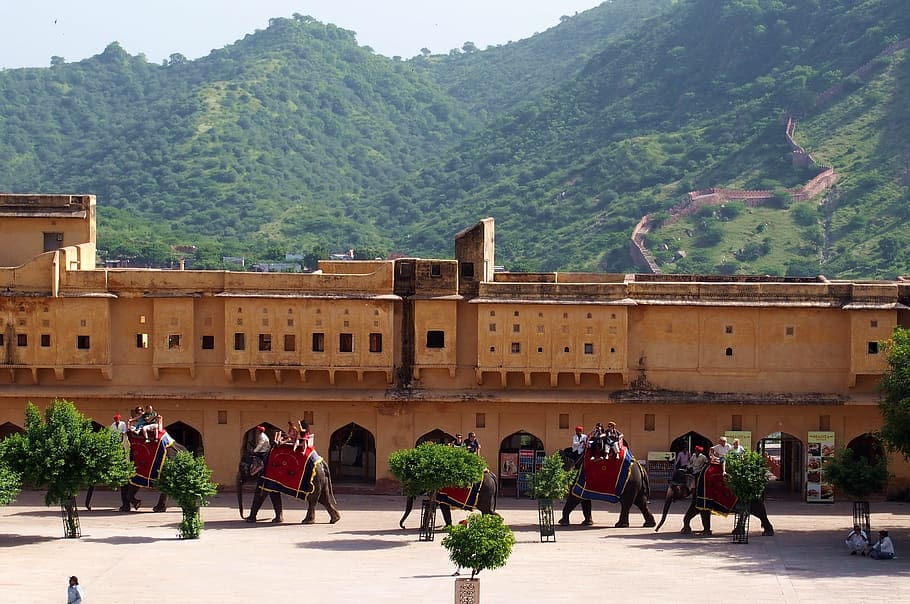
Jaleb Chowk, also known as “the quadrangle where horses and elephants are tethered,” is where defense soldiers used to hold conquest processions with their combat rewards when they returned from a scuffle. The imperial family women viewed the parade via the web-patterned casements. As the principal doorway into the citadel, this Sun gate was built entirely of sentinels. Suraj Pol was given the name because it faces the rising sun on its eastern side.Stately procession and VIPs entered the fort solely through the Suraj Pol or Sun Gate.
Jaleb Chowk is mainly an Arabic tradition that means “a place for warriors to gather.” Jaleb Chowk is one of Amber Palace’s four courtyards, which were created during the reign of Sawai Jai Singh (1693-1743 AD). The top army leader, or “Fauj Bakshi,” used to direct the marches of the King’s private defenders at this location. However, Maharaja used to monitor the sentinels’ deputation. Jaleb Chowk also had horse stables. The sentinels had engaged the rooms on the upper floor.The historic Jaleb Chowk in Jaipur will soon be transformed into a “Global Art Square” to reflect the city’s affluent cultural heritage. An innovative artisan market is planned for the square, and a museum will be established in the adjoining old assembly building.
The main palace grounds are accessible via a spectacular stairs from Jaleb Chowk. The Sila Devi temple, located at the entry to the right of the stairs steps, was where the Rajput Maharajas rendered adoration from Maharaja Mansingh in the 16th century until the 1980s, when the royalty’s animal sacrifice ritual (sacrifice of a buffalo) was discontinued. On the right side of Jaleb Chowk, there is also a small yet beautifully constructed Sila Devi (an embodiment of Durga or Kali) shrine.
4) Hidden Tunnels: Secrets of the Past
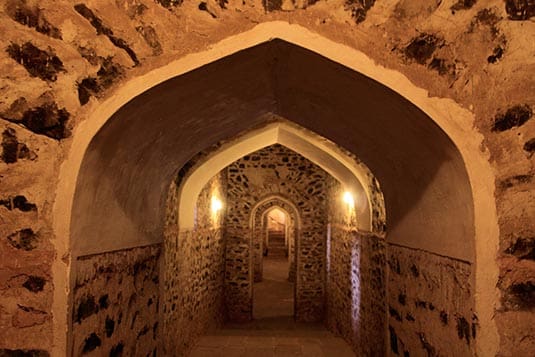
The history of the Underground Tunnels of Amber Fort in Jaipur, Rajasthan, is buried in mystery and supposition. While tangible historical records are few, the presence of these tunnels is well established in local folklore and oral traditions, which adds to their allure.According to one popular belief, these tunnels were built during the time of Raja Man Singh I, Amber Fort’s builder, in the late 16th century. At the time, the fort was the Kachwaha Rajputs’ capital, and they governed the region from their hilltop fortress. Recognizing the fort’s strategic value, Raja Man Singh I is thought to have directed the creation of a network of secret corridors beneath its walls.
These tunnels were supposedly utilized for a number of objectives, including covert communication and espionage, as well as strategic escape routes during sieges. With the fort perched on a steep hill and surrounded by difficult terrain, such underground routes would have allowed the rulers to covertly access the outside world or flee to safety in times of danger.Over the years, as power dynamics changed and the fort changed hands, the tunnels may have been enlarged, remodeled, or sealed off, depending on the demands and preferences of the ruling dynasty. Some tales state that the tunnels were used by consecutive generations of kings, while others indicate that they fell into neglect and were finally forgotten.
Despite the passage of time, the existence of these tunnels continues to fascinate historians, archaeologists, and tourists alike. While certain sections of the tunnels have been excavated and documented, the majority of its length and extent remain unknown, hidden beneath the earth and waiting to be discovered. Today, visitors to Amber Fort are reminded of the fort’s rich and colorful history, which includes tales of courage, intrigue, and mystery. The underground tunnels provide a tangible link to the past, providing a tantalizing insight into the lives of those who previously lived in this ancient fortress.
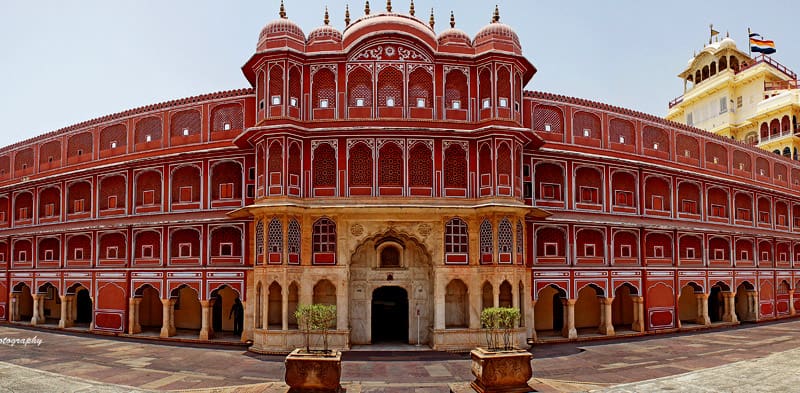
The City Palace in Jaipur, Rajasthan, is more than simply a majestic architectural marvel it’s also a treasure trove of fascinating anecdotes and intriguing fun facts that lend depth and charm to its long history. The City Palace, built in the 18th century by Maharaja Sawai Jai Singh II, is a tribute to the wealth and majesty of Rajput kings, providing tourists with insight into Rajasthan’s royal lifestyle and cultural legacy. Beyond its stunning façade and opulent interiors, the castle is full of secrets and surprises waiting to be uncovered.
One of the City Palace’s most remarkable features is its architectural combination of Rajput, Mughal, and European styles, which reflects the cultural syncretism that defined Jaipur during the medieval period. From its beautifully carved façade and towering courtyards to its ornate entrances and opulent halls, every corner of the palace oozes grandeur and elegance, capturing tourists’ imaginations.
The City Palace also houses the famous Chandra Mahal and Mubarak Mahal, two majestic palaces that highlight Rajasthan’s superb craftsmanship and architectural beauty. The current Maharaja of Jaipur’s mansion, Chandra Mahal, is known for its gorgeous peacock gate and intricately painted ceilings, while Mubarak Mahal, also known as the ‘Palace of Welcome,’ displays an intriguing collection of royal costumes and fabrics. One of the City Palace’s most prominent sights is the ‘Pritam Niwas Chowk,’ a courtyard with four beautifully carved doorways reflecting the four seasons of the year. Each entryway is adorned with unique seasonal motifs and symbols, such as flowers, birds, and legendary creatures, resulting in a visual extravaganza that celebrates the cyclical essence of time and life.
The City Palace reflects Rajput, Mughal and European architectural styles although the palace was designed to Vaastushastra treatise. Some of the famous gates are the ‘Udai Pol’, ‘Jaleb Chowk’, ‘Tripolia Gate’ and ‘Virendra Pol’, which also happen to be the various entrances to the palace. These are all richly decorated. The Palace has been designed according to a ‘grid style’ and houses various structures such as, ‘Chandra Mahal’, ‘Mubarak Mahal’, ‘Diwan-I-Khas’ and the ‘Govind Dev Ji Temple. The walls and gates are ornately designed to Mughal style, with various murals, lattice and mirrors adorning them from sides.
Nearby Tourist Attractions
- Hawa Mahal
- Jal Mahal
- Government Central Museum
- Jantar Mantar
- Vidhyadhar’s Garden
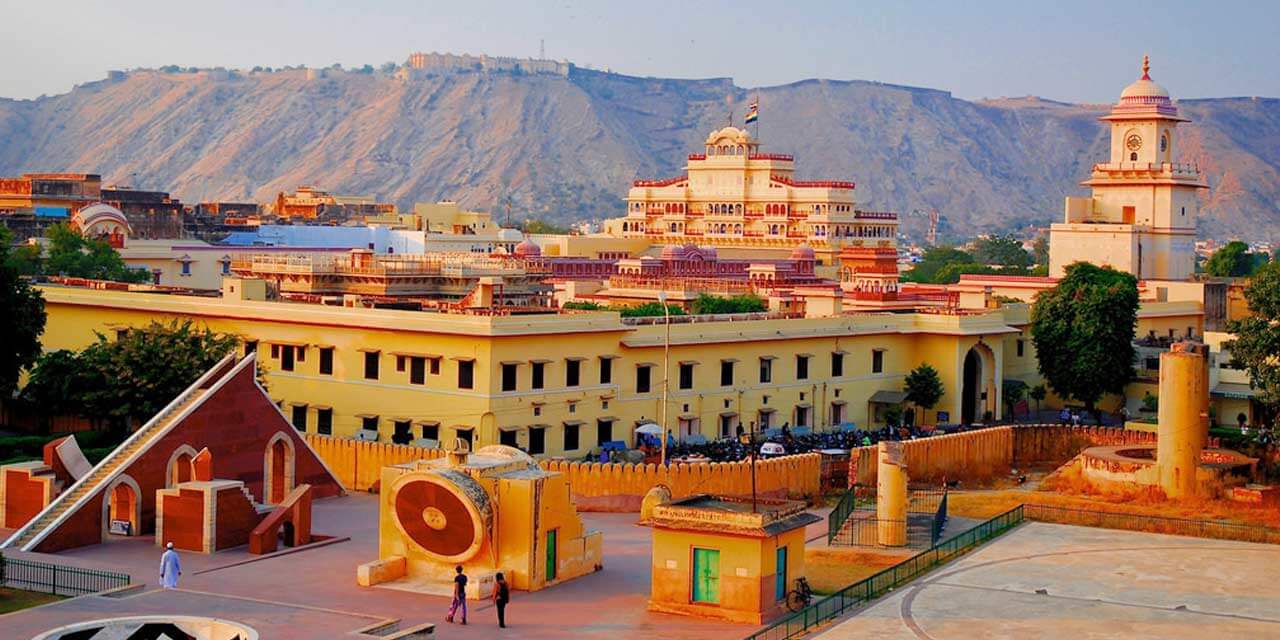
Jantar Mantar, A Timeless Journey through the Cosmos!
Jantar Mantar, located in the heart of Jaipur, Rajasthan, is a masterpiece of ancient astronomy and architectural design. Built by Maharaja Sawai Jai Singh II in the 18th century, this UNESCO World Heritage Site continues to astound tourists with its complex apparatus and precise astronomical observations. Aside from its scientific relevance, Jantar Mantar is home to a wealth of fascinating entertaining facts that shed light on its rich history and cultural heritage.
Jantar Mantar is an ideal place for those of us who like math and calculus in school. Standing at the observatory makes you feel as if the modest instruments in your geometry box have taken on a huge form. The semi-circles resemble the letter D, the triangles like their plastic counterparts, and the instrument markings resemble the scale. Some instruments remind you of the spinning globe.
One of the most amazing fun facts about Jantar Mantar is that it was one of the world’s largest observatories at the time. Jantar Mantar, which consisted of nineteen gigantic instruments such as sundials, astrolabes, and celestial globes, was a hub for astronomical research and observation, attracting intellectuals and astronomers from all over the world. The Samrat Yantra, or Giant Sundial, is one of Jantar Mantar’s most recognizable devices and the world’s largest sundial. The Samrat Yantra, which stands 27 meters tall, throws a shadow that reveals the time of day with extraordinary precision. Its massive size and elaborate design demonstrate the Maharaja’s dedication to furthering the study of timekeeping and astronomy.
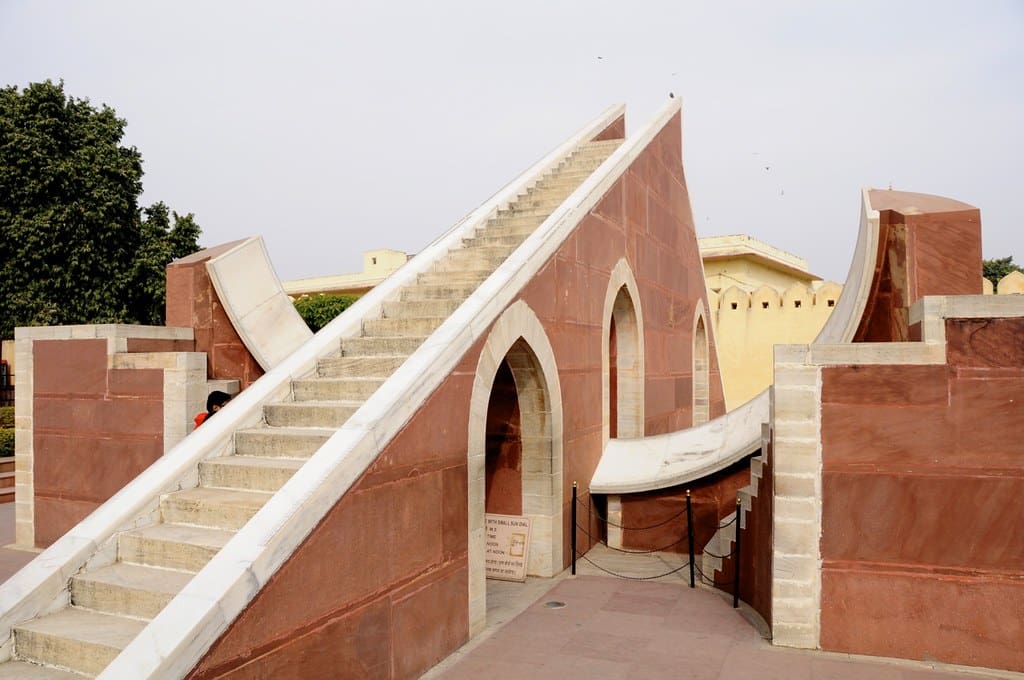
There are two Samrat Yantras one tiny and one large. The small one you notice as soon as you enter. The bigger one is positioned in the diagonally opposite corner and is the largest instrument in the complex. Both instruments follow the same idea. A triangle wall is aligned with Jaipur’s axis, resulting in a perfect North-South alignment. The local Jaipur time is visible in the shadow cast by this line as it falls on the semi-circular curves on both sides. The smaller, or Laghu Samrat Yantra, provides a time precision of 20 seconds, whilst the larger, or Vrihat Samrat Yantra, provides an accuracy of two seconds.
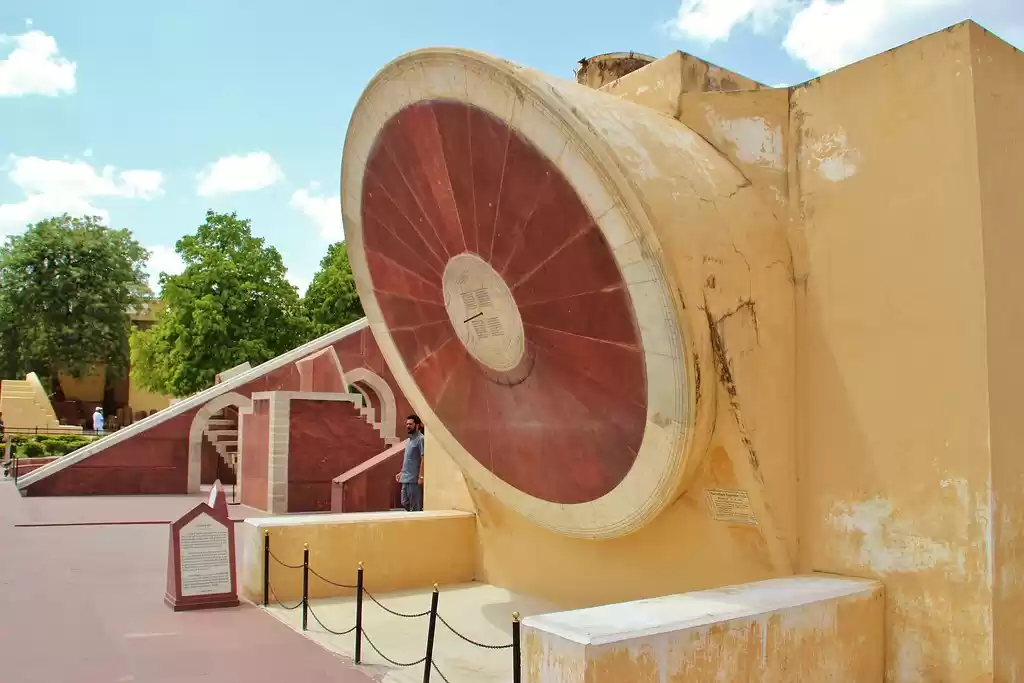
The Vrihat Smarat Yantra is a massive sundial located at the center of the Jantar Mantar observatory. This 27-meter-long sundial is recognized as the world’s tallest. The Samrat Yantra, which translates to supreme instrument,’ is an equinoctial sundial that measures time with a precision of two seconds.
The shadow of the yantra’s triangle wall, which is oriented north-south at an angle equal to the latitude of this site, travels equal distances at equal intervals of time in the eastern and western quadrants. This movement is standardized for calculating and interpreting local time.
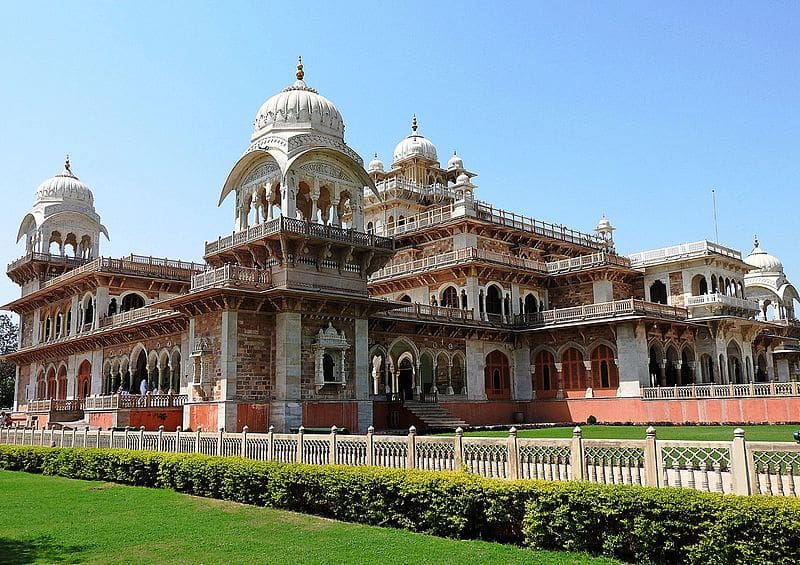
The Albert Hall Museum, located in the center of Jaipur, is very spectacular! It’s a great place to learn about Rajasthan’s royal history and rich traditions. The enormous museum was constructed in the late nineteenth century and is a treasure mine for historians and art enthusiasts. Sir Samuel Swinton Jacob designed the Albert Hall Museum, which was built in 1876. It was constructed to commemorate the visit of the Prince of Wales, Albert Edward. The museum is a stunning combination of Indo-Saracenic and European architectural styles.
The Albert Hall Museum is noted for its amazing art collection and galleries :
- Rajasthani Art: The museum features an excellent collection of Rajasthani miniature paintings. These artworks provide insight into the state’s rich history, people, and culture.
- Awords: The museum also houses a collection of ancient weapons and armor. The swords and daggers on display here are impressive.
- Textiles: Rajasthan is famous for its exquisite textiles, and the museum displays a diverse collection of traditional garments, materials, and costumes.
- Sculptures: A lovely sculpture gallery here has a collection of Hindu gods and goddesses.
- Egyptian Mummy: You’ll be surprised to see A 2,300-year-old Egyptian mummy within the museum.
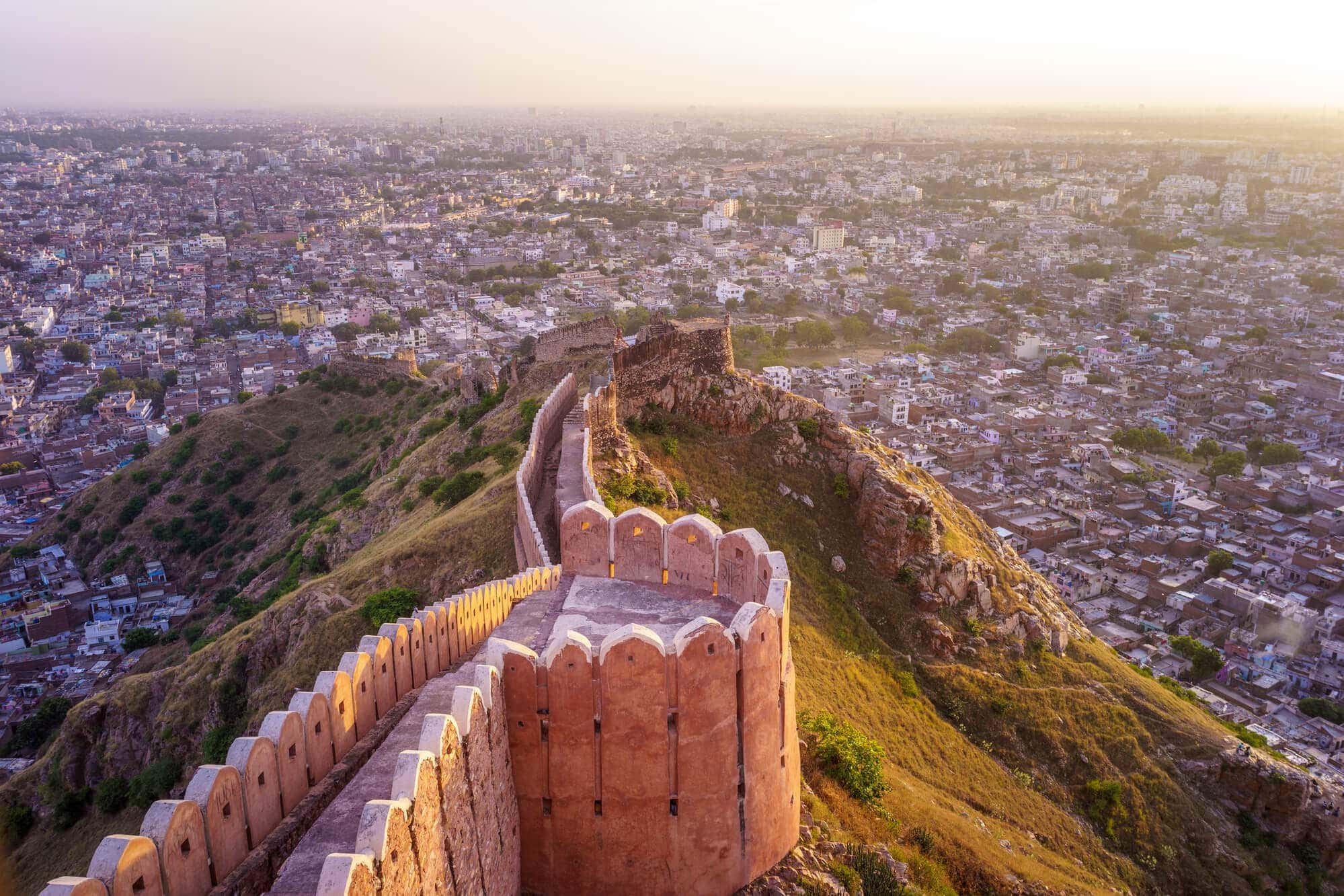
Conquer Nahargarh Fort and Claim Your Vista of Jaipur’s Beauty!
Nahargarh Fort, positioned magnificently on the Aravalli Hills overlooking the Pink City of Jaipur, is not only a symbol of regal legacy, but also a repository of interesting stories and amazing amusing facts.Nahargarh Fort was strategically placed on the edge of the Aravalli Hills, with a panoramic view of the surrounding countryside, including Jaipur. This strategic location not only provided a defensive stronghold, but also allowed the monarchs to keep a close eye on their domain.
Visitors to Nahargarh Fort are rewarded to stunning views of the Jaipur metropolis, particularly at sunrise and sunset. The fort provides an excellent vantage point for capturing the splendor of the Pink City against the backdrop of the Aravalli Hills, making it a favorite destination for photographers and nature lovers.Nahargarh Fort is embellished with elaborately carved statues, frescoes, and architectural elements that demonstrate the artistic abilities of past craftsmen. The fort’s architectural beauty, which ranges from intricate pillars and lattice windows to delicate floral motifs and geometric designs, demonstrates the artistry of its builders.
For adventurers, Nahargarh Fort provides chances for trekking, mountaineering, and birdwatching in its gorgeous environs. The peaceful trails leading up to the fort offer a welcome respite from the hustle and bustle of city life, allowing tourists to reconnect with nature and absorb up the tranquility of the Aravalli Hills.Nahargarh Fort comes alive at night, particularly on weekends, when it becomes a famous nightlife destination. The fort’s rooftop restaurants and cafes provide breathtaking views of the city lighted by the starry sky, providing a magnificent atmosphere for diners and revelers alike.

Jaigarh Fort is also known as the “Fort of Victory” because of its tremendous fortifications and unassailable walls. Maharaja Jai Singh II built the fort in the early 18th century as a military bastion to defend the kingdom of Amer.One of Jaigarh Fort’s most remarkable features is the enormous cannon known as “Jaivana.” Jaivana, built in the 18th century, holds the Guinness World Record for the world’s largest cannon on wheels. It weighs more than 50 tons and has a 20-foot barrel length, making it a devastating weapon for its day.
Jaigarh Fort houses a remarkable armory that once served as a repository for weapons, artillery, and armor used by the Rajput warriors. Visitors can explore the armory’s collection of swords, shields, cannons, and firearms, offering insight into the martial traditions and military prowess of the Rajput rulers. Legends abound about secret tunnels and underground passages beneath Jaigarh Fort, which connect it to the nearby Amer Fort and serve as escape routes during sieges. While some of these tunnels have been blocked off, their presence lends mystery and fascination to the fort’s history.
Jaigarh Fort, located at an elevation of more than 500 meters above sea level, provides stunning panoramic views of the surrounding terrain, which includes the Amer Fort, Maota Lake, and Jaipur. Visitors can climb to the fort’s highest point to get panoramic views of the scenic surrounds.
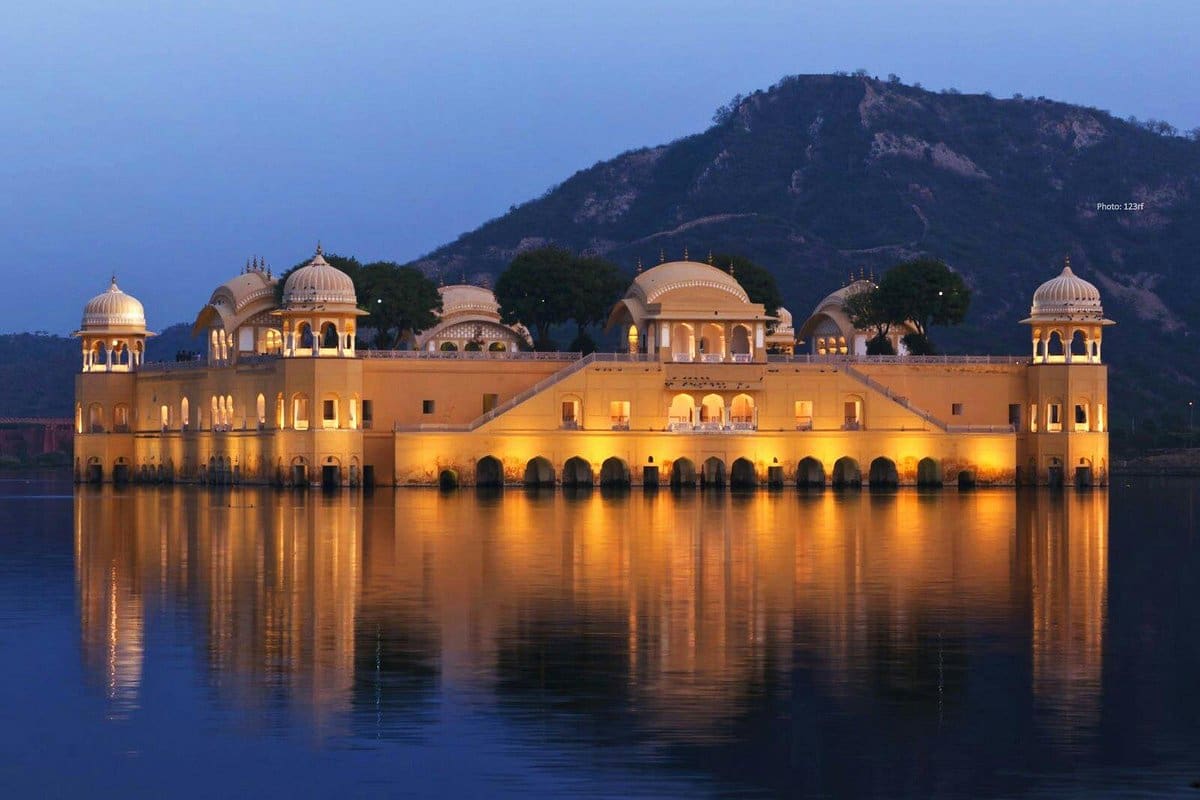
Explore the Serene Secrets of Jal Mahal
Jal Mahal, which translates to “Water Palace,” is also known as the “Floating Palace” because to its placement in the center of Man Sagar Lake in Jaipur, India. It appears to float on the water, producing a breathtaking spectacle. Jal Mahal, constructed in the Rajput architectural style, is a stunning fusion of Mughal and Rajput elements. The red sandstone used in its construction contrasts nicely with the pure white marble domes.
Jal Mahal, one of Jaipur’s most popular tourist attractions, has no written history of who built it or when. However, it is widely believed that Maharaja Sawai Pratap Singh built Jal Mahal in 1799 to serve as a hunting lodge for his duck shooting expeditions. Some people credit Maharaja Madho Singh I with building this palace, which dates back to the 1750s. Regardless matter who built it, the palace was never intended to be used as a typical living space.
Maharaja Jai Singh II of Amber rebuilt the palace in the 18th century. The structure sank over time as a result of lake water seepage and waterlogging. Following numerous years of degradation and neglect, renovations were carried out in the early twenty-first century to restore the palace to its former beauty. The palace and many of its features have been rebuilt, but the original terrace garden has not been rescued. Plans are underway to develop a new terrace garden styled after the rooftop garden of Jaipur’s famous Amer Palace.
Jal Mahal, surrounded by the scenic Aravalli hills, is not only an architectural marvel but also a sanctuary for migratory birds. Birdwatchers frequently visit the area to capture sightings of these flying visitors. When illuminated by lights at night, Jal Mahal takes on a mystical aspect. Its reflection on the peaceful waters of Man Sagar Lake produces a breathtaking spectacle that attracts visitors from all over. Today, Jal Mahal is one of Jaipur’s most recognizable attractions, drawing visitors with its ageless beauty, rich history, and tranquil setting amidst the sparkling waters of Man Sagar Lake.
- The charming rooftop garden of Jal Mahal is referred to as Chameli Bagh.
- Unlike typical residences, Jal Mahal lacks individual chambers inside, as it was primarily designed as a recreational area.
- Legend suggests that Jal Mahal was erected during a drought, when the lake beneath it had dried up entirely, making the entire structure visible during its construction.
- The robust construction of Jal Mahal’s stone walls, fortified with limestone mortar, effectively prevented water infiltration.
“As the Pink City welcomes you with warmth and charm, you’ll be captivated by its timeless elegance and the spirit of its people. So, as you say goodbye to Jaipur, take with you not only memories, but also a deep appreciation for the limitless beauty that awaits you in every part of this enchanting city.”
AirAsia has announced its first new route for 2024, with flights between Kuala Lumpur International Airport (KUL) in Malaysia and Jaipur Airport (JAI) in India. The four weekly flights begin on April 21, 2024 and will run until March 19, 2025.
For Flights : (Air Asia MOVE)
Source / Image : Rajasthan Tourism
Follow us on Instagram, Facebook or Telegram for more updates and breaking news.


